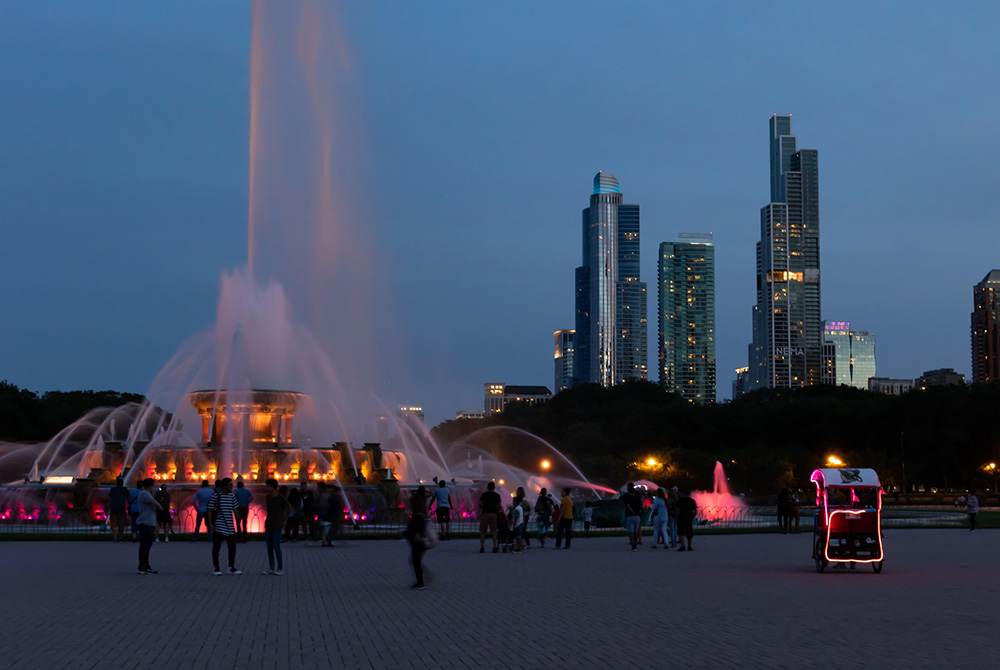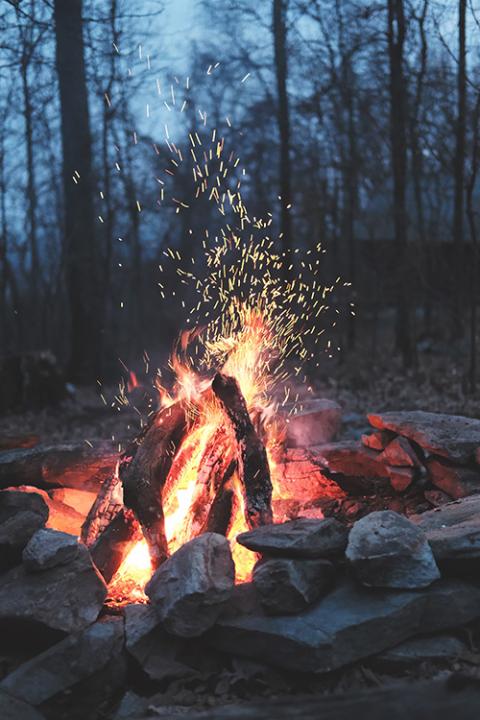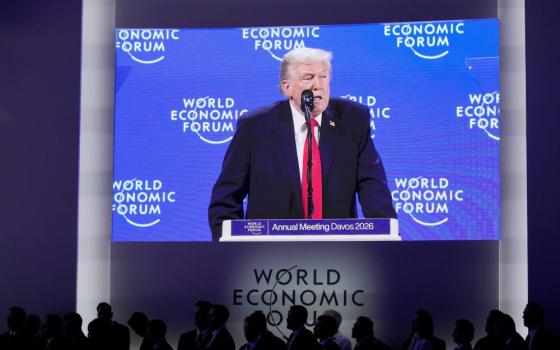
Buckingham Fountain in Chicago (Unsplash/Cole Parsons)
Think of a fountain, gushing and giant, such as Buckingham Fountain in Grant Park, Chicago. The clean, clear water flows abundantly, mesmerizing crowds. With a geyser that is 150 feet high and a surrounding pool with a diameter of 280 feet, its presence is prominent. Crowds are soaked by the mist; no one can be near the fountain without being changed. The water flows and changes in every encounter, as creatures wash, drink and share life.
This, for me, is an image of religious life. Those of us who are vowed are part of the giant, central stream of water that flows out, connected to a greater source. Just as Buckingham Fountain is centered between Chicago and Lake Michigan, we are centered among the people of God and God's infinite love. Rooted in our vowed Catholic identity, we are a mighty force that flows outward. We give witness and offer life, while others influence us. Together, we are like a wellspring for anyone who is thirsty or in need.
Now think of a campfire. The colors of flames dance and glow as the air and heat flow through, transforming wood into energy. Compared to the fountain, the fire's presence is ordinary and a space for community. Those gathered provide the necessary stirring, fuel and air to keep the fire lively. Then the fire illumines the dark and exudes warmth, providing restoration and calm — and potential to cook food to nourish pilgrims. All who connect to the fire can be restored, changed; and the fire needs the influence of others.
For me, this image of an ordinary campfire is also an image of religious life. Activated by the flow of the Spirit, those of us who are living vowed lives collectively transform elements of our lives into energy that fuel others. Ideally, through our vowed witness and prayer, we share of the abundance so that anyone who comes close is changed for the better. Community is built. At the same time, we need outside influences to keep us strong and vibrant. This is the potential of a good fire; and it is also the potential of religious life.

(Unsplash/Timothy Meinberg)
But what if no one has a chance to encounter the prominent fountain or the ordinary campfire? What if religious life is shifting so much that it seems to others that the gifts of fountain and fire feel exclusive, as if they are behind a giant fence?
As I prepared to profess my final vows as a Franciscan Sister of Perpetual Adoration some years ago, I struggled with how my desire to commit to this radical lifestyle lined up with the reality that religious affiliation is decreasing and many are less trusting of institutions. As I saw it (and still see it) my vows are for the sake of all of God's people; no matter their belief in a creed or Church attendance, every person is a child of God. But what difference would my vows make if vowed life is unknown or misunderstood? More broadly, I wondered what role Catholic sisters are meant to have in Church and society during these shifting times.
In recent years, I've been hearing Catholic sisters talking about the privilege of our sisterhood. Wealth is created when we pool our resources, energy and life. In a society that promotes individualism and competition, we are committed to the pursuit of the common good, sharing our wealth, our power and love inclusively, prophetically. While post-industrial societies reel from the impacts of loneliness, we share life as community. Building community is countercultural, and this is who we are.
Part of our privilege is the power that comes from being in a collective. Paul Engler teaches that "individual action isn't what actually creates change." Our communities, though, are social movements. Together we really do make a difference — like a campfire or a giant fountain, we are a mighty force.
Our vow of poverty insists that we don't possess or claim anything for our own. We are called to share, to invite others to the fountain and the fire. But how do we do this without insisting that they adopt our entire lifestyle or belief system?
Advertisement
Last year I felt a call to start a new community and house of hospitality, to offer others access to the fountain and fire of religious life. I now live in The Fireplace along with another Catholic sister, Sharon Dillon, a Sister of St. Joseph of the Third Order of St. Francis, and two other women in their 20s. More are applying to live with us and several others are part of our extended community.
Each week the residential community has a house meeting to discuss the shape of our shared life. On Tuesday and Thursday evenings we welcome guests to eat and pray with us. On any given day or night, we gather neighbors for conversation or connection. We also host programs and events for artists and spiritual seekers, such as one with author and scholar Jon M. Sweeney on Nov. 13 and an Advent Art event with the artist Kiki McGrath on Dec. 5 this year. We aim to be a spiritual refuge to artists, activists and spiritual seekers — a place where creative changemakers can come for renewal. As we come to know others in each encounter, they enliven and expand us too.
A few months ago, when Sr. Sharon Dillon and I were interviewing one of the applicants to The Fireplace, the conversation moved to motivation and vision, to how the forming of The Fireplace community was an outgrowth of religious life. Together we reflected on church history, and how the accessibility of women religious to the common person has shifted. Even during medieval times when Europe was dotted with monasteries, people knew where the women religious were and how to turn to them for guidance and assistance.
Today women religious are aging, often accessible only to those already in their networks. Yet we are made to be a mighty force in church and society and we only thrive when we are enlivened by outsiders. In order for women religious to remain relevant, impactful and reachable, the molds and boxes must be broken down; this is a time for new structures and models.
The Fireplace is one example and there are many other emergent forms of religious life, communities and places where the old is mixing with the new. Each time a new form sprouts forth, religious are offering space at the fountain and the fire. We are strengthened and energized by each encounter. We build community, remain reachable, share of our abundance and are enriched by others. In this flow, all are transformed.





